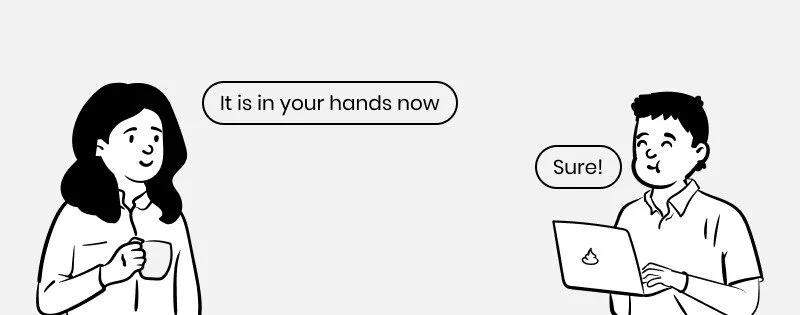Freely
Mental health support offered from employers to employees
By Priscila Ferreira
Freely is a mobile app that offers mental health support. The service offers a benefit from employers to employees in a preventative way, and can be used anywhere and in anonymous usage.
The Challenge
Improve the mental health of employees due to the pandemic.
Because of the pandemic, some companies in Switzerland had to implement a new home office setup. After a few months, they noticed that the productivity and happiness of their employees decreased a lot. To avoid further problems, the companies would like to find a solution to offer mental health support to their employees in a preventative way.
My Journey
Starting from scratch
I joined Freely in September 2020. My position inside the cross-functional team of 7 (two Business Developers, one Growth Marketer, a Product Owner and three developers) was UX/UI Designer.
My position was REMOTE, due to the pandemic but also because the other members of the team were based in Zurich and Kiev. But we had a lot of online meetings.
We had no idea on which product we were going to build. There was already some data from marketing research and competitors. Together with the team, I took a close look on the data in order to suggest the best way to start.
The UX Process
User Research - Qualitative interview (I was missing some information from the user’s side)
Co-Creation- Design Sprint
User Testing - Outcomes from the Design Sprint
Design - Prototype 2.0
App Development - Pixel perfect
Hand-off - Development
User Research
The assumptions to be validated
Together with the team, we discussed and I came up with the 3 main assumptions to be validated:
A significant number of people in Switzerland want to improve their mental well-being and reduce symptoms like anxiety, depression, stress & sleeping problems
People want support for their light mental health problems but they have some pain points that are the main impediment. (e.g. costs, stigma)
Employees want to use mental health support offered by their employer
User Profile (target group criteria)
We decided to use the following user profile:
Any gender & between 20 to 55 years
Employed in companies with home office setup
Recently had one or more of the following symptoms: difficulty sleeping, regular stress, motivation problems, periods of a bad mood, or reduced concentration
User Interview goal
Besides the assumptions that we wanted to validate, the goals that we defined for the user interview were:
Understand how people self-assess their mental health
Understand what blockers prevent people to look for help
Understand which features (services) would be important for the users
Interview Insights -
10 people
Mental well-being - More than half of the people suffer from difficulties to sleep, motivation problems, stress, and reduced concentration.
They don’t really do anything to get better.
Willingness to improve - 60% of the interviewed people want to improve their mental well-being. But in the other hands, they don’t think that their problem is severe enough.
Support from employers - Employees would be willing to receive mental health support provided by the employer at no additional cost, but only if the solution is completely anonymous.
Features expectations - Learn how to deal with the own thoughts / situations as well as receive recommendations.
Product expectations Not mentioned. The majority said that they would use a product only if it is not on the company’s devices.
Core user’s need
Well-being - Improve quality of life
Get better - Be able to deal with the symptoms
Learn - How to break down the stigmatisation of therapy/mental health
User persona based on interview findings
Co-creation
Design Sprint
At this point, we already had very good information about the user and their needs. To start ideating our product, we decided to run a Design Sprint with the goal to come up with a concept and get it ready to test with some users. The Design Sprint took 4 days and it was REMOTE.
As I wanted to contribute with ideas, I kindly asked a Design from another team to be the facilitator. The people involved in the session were:
The Experts - HR manager & Therapist - only in the first day
The project team - Product Manager, Venture Architect, Designer, Growth Marketer, Developer & Myself - UX Designer :-)
And everything start with the “How might we?”
“How might we design a product that makes our users feel comfortable to break the stigma around mental health and, help them to improve their mental well-being?”
And the outcomes from the session helped the team to define features & value proposition. It was a great collaborative work!
Wireframes
Design Sprint outcomes:
Understand - Different perspectives: HR, Therapist & Users
Sketch- Ideating potential solutions
Decide - Voting and giving feedback
Prototype - From the storyboards
Validate - Test the outcomes!
Top 3 Value Proposition - what was considered as a potential solution?
Mobile app (give the freedom to the end-user) with easy digital access to help
Anonymous usage (data privacy)
Preventative approach & content developed together with experts
The first prototype
With this first prototype, we could validate the initial features. It was also possible to quickly build it by using the company’s Design System.
Prototype test insights
Mobile app: 4 from 5 users would like to have a mobile app because it can be used in their persona phones.
Onboarding: 5 from 5 users could complete the onboarding process with no difficulties.
Antonymous usage & chatbot: They all perceive the anonymous usage as safe and friendly. The chat bot was highlighted many times as nice. They felt that there is a real person talking to them.
Educational preventative approach: 3 from 5 like the educational preventative approach. The other two would prefer talking to a therapist and focus on treatment of light mental issues.
They all mentioned that would like to have something personalised. E.g content according to their interest.
Prototype 2.0
Evolution of the features
After reviewing all the insights, I came up with a more detailed plan of the features that we should implement in the MVP.
I was aware of the deadlines in the roadmap, but I was confident that the suggestions would deliver the minimal value to the users.
Introducing Freely
Freely is a mental health support for companies that wants to offer it as a benefit to their employees.
Branding development
In order to ensure a great look and feel of the app to our users, I decided to start creating the brand assets in parallel. The name Freely was already decided by the team after a brainstorm session.
Starting with a moodboard: My idea with the moodboard was to bring together relaxing colors and natural elements that might give to the people the feeling of peace and calmness.
Logo: Freely logo was created with handwritten typography that adds a personal touch.
Color Palette: A combination of the most relaxing colors you should choose stress-free life.
Image Style:
People matters
Using real pictures of people to bring emotional
feelings to the brand.
Illustration Style:
Line art & abstract shapes
A Visual language of shape, form, color and line to create a modern composition.
Introducing Freely
A mental health support for companies that wants to offer it as a benefit to employees.
Emotional onboarding & anonymous access
The chatbot assistant guides the users through during the onboarding process
It also offers anonymous access by asking the user to choose a nickname and an avatar when setting up the account
Assessment of own emotional health via questionnaires
Employees are asked a few wellbeing questions
when first install the app to help point them towards the most useful support for them right now.
Psycho education & self help with personalized content
The user will receive the recommended content according to the results from the previous assessment questionnaire
Mood tracker
Tracking mood is a good habit and Therapists usually recommend it to patients who want to improve their mental health. Also part of the Freely journey.
Employees can talk to a Therapist in one click
Users can to talk to a therapist via message if they need it (or just want it), phone call sessions with qualified therapists can be booked quickly and easily too.
How I got here
The tools that helped me to make this project live are: Figma (Prototype) Photoshop (to edit images), Trello (tasks manager), Google Hangouts Meet (for team communication) & Miro (collaborative board).
Hand off
Every project, I like to take learnings and create new ways to make a smooth hand off. For this project, I did the following process:
I set up a minutes meeting to demonstrate my designs and I also recorded and made it available in case they would have questions later on.
I also created a template to better explain the user interface and visual aspects.
I added all the relevant information in this document: who is the owner, JIRA link, Content link & image folders. This helps a lot and I have receive very good feedback on that :-)
We delivered the MVP, what comes now?
What you have seen here is the scope for the MVP. After development, we will continue testing and improving the product. A Diary study user testing will be the next step. It will be interesting to see what is the user perception when using the product and which impact is going to be create in their lives.




















